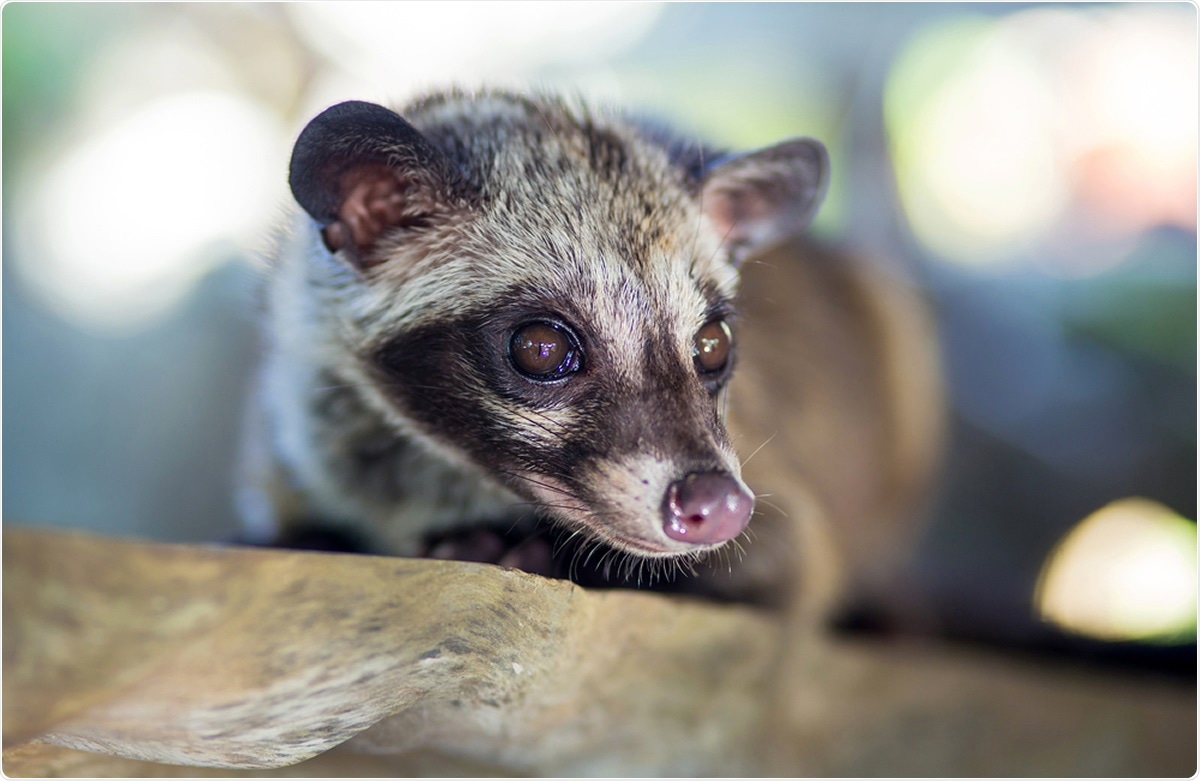Researchers at the University of Liverpool, UK, have shown that the number of novel coronaviruses that could be generated in wild and domesticated animals is currently largely underestimated.
The team used a machine-learning pipeline to calculate the probability of different viruses combining in the same animal (recombination host) to produce new strains of coronaviruses.
The researchers predicted many more associations between coronaviruses and host species than have been observed to date. They also predicted 30 times more potential recombination hosts of severe acute respiratory syndrome coronavirus 2 (SARS-CoV-2) – the agent that causes coronavirus disease 2019 (COVID-19).
Furthermore, the team flagged up potentially high-risk species that they recommend for coronavirus surveillance.

Asian Palm Civet. Image Credit: trubavin / Shutterstock
“Our results strongly suggest that the potential array of viruses which could recombine in hosts is substantially underestimated, reinforcing the message that continued monitoring is essential,” writes Maya Wardeh and colleagues in the journal Nature Communications.
Concerns about novel coronaviruses emerging in the future
Following the emergence of three novel respiratory coronaviruses from mammalian reservoirs into human populations over the last 20 years, one of the most pressing questions researchers face is which animal species will be potential reservoirs in the future?
Seven coronaviruses are now known to infect humans, three of which can cause severe disease (SARS-CoV-1, SARS-CoV-2, and Middle East respiratory syndrome [MERS]-CoV), while the remaining four generally cause milder symptoms.
Novel pathogenic coronaviruses arise through homologous recombination – a process that generates new combinations of genetic material from two similar parent strains of the virus that co-infect an individual host. The genetic material of the progeny virus contains sequences from each of the parent strains.
Homologous recombination has previously been demonstrated in several important viruses and is thought to underlie the emergence of both SARS-CoV-1 and SARS-CoV-2.
“Recombination events between two compatible partner strains in a shared host could thus lead to future novel coronaviruses,” writes Wardeh and the team. “However, our understanding of which hosts are permissive to which coronaviruses, the prerequisite to identifying which hosts are potential sites for this recombination, remains extremely limited.”
What did the researchers do?
The team used a machine-learning pipeline to predict associations between coronaviruses and their potential mammalian hosts.
The pipeline considered the genomic features of 411 coronavirus strains, the ecological, phylogenetic and geospatial traits of 876 potential mammalian hosts, and the characteristics of the network linking coronaviruses to their observed hosts.
What did they find?
The team predicts 11.5 times more coronavirus–host associations and over 30 times more potential recombination hosts of SARS-CoV-2 than have been observed to date.
Overall, the pipeline predicted that 4,438 previously unobserved associations potentially exist between 300 mammals and 204 coronaviruses. It also predicted that a total of 126 mammalian species are hosts of SARS-CoV-2.
Overall, the model flagged up 231 mammalian species that could host ten or more of the 411 coronavirus strains.
“These hosts of multiple coronaviruses are potential sources of new coronavirus strains by homologous recombination,” say the researchers.
The model predicted known recombination hosts
Next, the team identified candidate hosts that could generate novel pathogenic coronavirus strains and predicted which species are therefore, high priority targets for surveillance.
Interestingly, the model correctly highlighted some known important recombination hosts of coronaviruses.
For example, the Asian palm civet was predicted as a potential host of 32 coronaviruses, in addition to SARS-CoV-2.
Genetic evolution analysis has already shown that SARS-CoV-2 is closely related to coronaviruses derived from this animal. Studies have also highlighted the Asian palm civet as a reservoir for SARS-CoV-1, says Wardeh and colleagues.
Furthermore, the model highlighted the intermediate horseshoe bat, which studies have previously pointed to as a recombination host of SARS-CoV-2.
“The successful highlighting of speculated hosts for SARS-CoV and SARS-CoV-2 homologous recombination adds substantial confidence that our model is identifying the most important potential recombination host,” writes the team.
What other species did the study highlight?
The pipeline also identified various species that are not yet associated with SARS-CoV-2 recombination but have been predicted as hosts of SARS-CoV-2 and other coronaviruses.
The researchers say a high-priority species is the lesser Asiatic yellow bat, a known but understudied host of coronaviruses.
The model also predicted the common hedgehog, the European rabbit, and the domestic cat as hosts of SARS-CoV-2 and multiple other coronaviruses.
The most prominent result for a SARS-CoV-2 recombination host was the domestic pig associated with an additional 121 coronaviruses.
“The pig is a major known mammalian coronavirus host,” says the team.
The authors recommend a targeted surveillance program
The researchers say the findings suggest that homologous recombination potential between coronaviruses is substantially underestimated using observed data alone.
“The potential ability of the large numbers of hosts presented here to be hosts of multiple coronaviruses, including SARS-CoV-2, could provide the capacity for homologous recombination and hence potential production of further novel coronaviruses,” writes Wardeh and colleagues.
However, given the extent of mammalian host reservoirs and the potential recombination hosts identified here, a targeted surveillance program is now possible.
Such a program could help inform prevention and mitigation strategies and provide a vital early warning system for future novel coronaviruses, concludes the team.